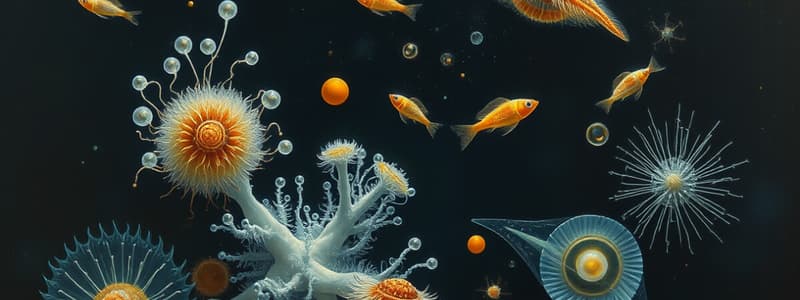Podcast
Questions and Answers
How are marine organisms classified?
How are marine organisms classified?
Where they live and how they move
What are the three types of marine organisms?
What are the three types of marine organisms?
- Benthos (correct)
- Nekton (correct)
- Plankton (correct)
- Zooplankton
Define Plankton (drifters).
Define Plankton (drifters).
All organisms (algae, animals, bacteria) that drift with the ocean currents, swim weakly, and cannot determine their horizontal position within the ocean.
What type of organism makes up most of Earth's biomass?
What type of organism makes up most of Earth's biomass?
What percent of marine species are bottom dwelling?
What percent of marine species are bottom dwelling?
Define Phytoplankton.
Define Phytoplankton.
Define Zooplankton.
Define Zooplankton.
Define Bacterioplankton.
Define Bacterioplankton.
Define Picoplankton.
Define Picoplankton.
Define Virioplankton.
Define Virioplankton.
What are three ways plankton can be classified?
What are three ways plankton can be classified?
Define Holoplankton.
Define Holoplankton.
Define Meroplankton.
Define Meroplankton.
Define Macroplankton.
Define Macroplankton.
Define Nekton.
Define Nekton.
What limits the movement of Nekton?
What limits the movement of Nekton?
Define Benthos.
Define Benthos.
What are the three types of benthos?
What are the three types of benthos?
Define epifauna.
Define epifauna.
Define infauna.
Define infauna.
Define nektonbenthos.
Define nektonbenthos.
What happens to benthos when moving across the bottom from the shore into deeper water?
What happens to benthos when moving across the bottom from the shore into deeper water?
What do organisms of the deep ocean feed on?
What do organisms of the deep ocean feed on?
When were deep-sea vent bio-communities discovered, and where?
When were deep-sea vent bio-communities discovered, and where?
What are the basis of the deep sea food web?
What are the basis of the deep sea food web?
Flashcards are hidden until you start studying
Study Notes
Classification of Marine Organisms
- Marine organisms are classified based on their habitat and mode of movement.
- Main categories: Plankton (drifters), Nekton (swimmers), Benthos (bottom dwellers).
Types of Marine Organisms
- Plankton: Comprising algae, animals, and bacteria that drift and have limited swimming ability.
- Nekton: Organisms capable of independent movement through swimming or propulsion.
- Benthos: Organisms that live on or in the ocean floor.
Plankton Definitions
- Plankton: Account for most of Earth's biomass.
- Phytoplankton: Autotrophic, perform photosynthesis, varying in size from microscopic algae to larger drifting kelp.
- Zooplankton: Heterotrophic, includes drifting marine animals.
- Bacterioplankton: Free-living bacteria, more abundant than previously thought, extremely small.
- Picoplankton: Even smaller than Bacterioplankton.
- Virioplankton: Comprises bacteriophages and algal viruses, not well understood.
Plankton Classification
- Plankton can be classified by feeding style, lifecycle stages spent as plankton, and size.
- Holoplankton: Spend their entire life as plankton.
- Meroplankton: Spend juvenile or larval stages as plankton and adult stages as nekton or benthos, e.g. squid.
- Macroplankton: Large floating forms like jellyfish and Sargassum.
Nekton Characteristics
- Nekton can move independently of currents and undertake long migrations.
- Includes adult fish, marine mammals, reptiles, and certain invertebrates.
- Their movement can be limited by temperature, salinity, water pressure, viscosity, and nutrient availability.
Benthos Definitions
- Benthos: Organisms residing on or in the ocean bottom.
- Types of benthos include:
- Epifauna: Live on the seafloor surface, either attached or moving along it.
- Infauna: Burrow in sand, shells, or mud on the seafloor.
- Nektonbenthos: Live on the bottom but can also swim or crawl above the ocean floor.
Benthos Population Dynamics
- As benthos move from shallow areas to deeper waters, their numbers remain constant, but biomass decreases due to resource limitations in deeper habitats.
Deep Ocean Ecosystems
- Deep ocean organisms primarily feed on each other and nutrients sinking from the surface.
- Deep-sea vent bio-communities discovered in the late 1970s in the Galapagos Rift.
- Archaebacteria are foundational to the deep-sea food web.
Studying That Suits You
Use AI to generate personalized quizzes and flashcards to suit your learning preferences.




